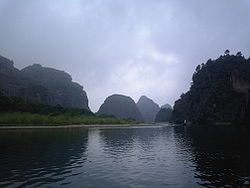- Mount Longhu
-
Taoism 
This article is part of a series on TaoismFundamentals Dao (Tao) · De (Te) · Wuji · Taiji · Yin-Yang · Wu Xing · Qi · Neidan · Wu wei Texts Laozi (Tao Te Ching) · Zhuangzi · Liezi · Daozang Deities Three Pure Ones · Guan Shengdi · Eight Immortals · Yellow Emperor · Xiwangmu · Jade Emperor · Chang'e · Other deities People Laozi · Zhuangzi · Zhang Daoling · Zhang Jue · Ge Hong · Chen Tuan Schools Tianshi Dao · Shangqing · Lingbao · Quanzhen Dao · Zhengyi Dao · Wuliupai Sacred sites Grotto-heavens · Mount Penglai
Taoism Portal
Mount Longhu (Chinese: 龙虎山; pinyin: Lónghŭ Shān; literally ""Dragon Tiger Mountain"", Gan: Lung-fu San), is located in Jiangxi, China. It is famous for being one of the birthplaces of Taoism, with many Taoist temples built upon the mountainside. It is particularly important to the Zhengyi Dao as it the Shangqing Temple and the Mansion of the Taoist Master are located here.[1]
Two of them are the temples of Immortal City (仙岩) and Zheng Yi (正一), all founded by Zhang Daoling (张道陵), the Han Dynasty founder of the religion. There are more Taoist temples in nearby Shangqing Town (上清). One of the temples in Shangqing is mentioned in the beginning of the famous Chinese novel (水滸傳) "Outlaws of the Marsh".
Mount Longhu also has cultural significance has a historical burial site of the Guyue people, who placed their dead in hanging coffins on the mountains cliff faces.[2]
In August 2010 UNESCO inscribed Mount Longhu on the World Heritage List as part of the complex of six sites that make up the China Danxia[3].
Mount Longhu can be reached from the nearby city of Yingtan.
Gallery
References
Categories:- Taoism
- Taoist temples in China
- Way of the Celestial Masters
- Visitor attractions in Jiangxi
- Mountains of China
- Global Geoparks Network members
Wikimedia Foundation. 2010.



